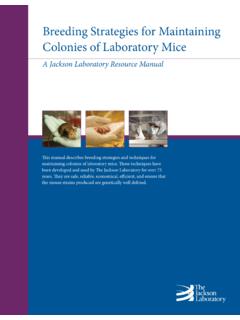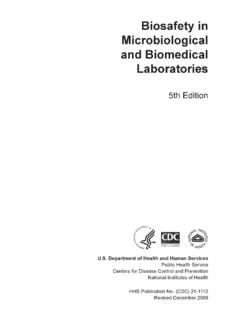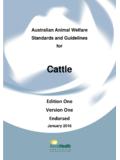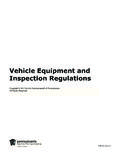Transcription of LABORATORY METHODOLOGIES FOR BACTERIAL …
1 GUIDELINE LABORATORY METHODOLOGIES FOR BACTERIAL . ANTIMICROBIAL SUSCEPTIBILITY TESTING. SUMMARY. Historically, medical practitioners and veterinarians selected antimicrobials to treat BACTERIAL infectious diseases based primarily on past clinical experiences. However, with the increase in BACTERIAL resistance to traditionally used antimicrobials, it has become more difficult for clinicians to empirically select an appropriate antimicrobial agent. As a result, in-vitro antimicrobial susceptibility testing (AST) of the relevant BACTERIAL pathogens, from properly collected specimens, should use validated methods. Thus, AST is an important component of prudent antimicrobial use guidelines in animal husbandry worldwide and veterinarians in all countries should have these data available for informed decision-making.
2 Although a variety of methods exist, the goal of in-vitro antimicrobial susceptibility testing is to provide a reliable predictor of how an organism is likely to respond to antimicrobial therapy in the infected host. This type of information aids the clinician in selecting the appropriate antimicrobial agent, aids in developing antimicrobial use policy, and provides data for epidemiological surveillance. Such epidemiological surveillance data provide a base to choose the appropriate empirical treatment (first-line therapy) and to detect the emergence and/or the dissemination of resistant BACTERIAL strains or resistance determinants in different BACTERIAL species. The selection of a particular AST method is based on many factors such as validation data, practicality, flexibility, automation, cost, reproducibility, accuracy, and individual preference.
3 The use of genotypic approaches for detection of antimicrobial resistance genes has also been promoted as a way to increase the speed and accuracy of susceptibility testing. Numerous DNA- based assays are being developed to detect BACTERIAL antibiotic resistance at the genetic level. These methods, when used in conjunction with phenotypic analysis, offer the promise of increased sensitivity, specificity, and speed in the detection of specific known resistance genes and can be used in tandem with traditional LABORATORY AST methods. INTRODUCTION. The spread of multiple antimicrobial-resistant pathogenic bacteria has been recognised by the World Organisation for Animal Health (OIE), the Food and Agriculture Organization (FAO) and the World Health Organization (WHO).
4 As a serious global human and animal health problem. The development of BACTERIAL antimicrobial resistance is neither an unexpected nor a new phenomenon. It is, however, an increasingly troublesome situation because of the frequency with which new emerging resistance phenotypes are occurring among many BACTERIAL pathogens and even commensal organisms. Historically, many infections could be treated successfully according to the clinician's past clinical experience ( empirical therapy); however, this is becoming more the exception than the rule (Walker, 2007). Resistance has been observed to essentially all of the antimicrobial agents currently approved for use in human and veterinary clinical medicine. This, combined with the variety of antimicrobial agents currently available, makes the selection of an appropriate agent an increasingly more challenging task.
5 This situation has made clinicians more dependent on data from in-vitro antimicrobial susceptibility testing, and highlights the importance of the diagnostic LABORATORY in clinical practice. A number of antimicrobial susceptibility testing (AST) methods are available to determine BACTERIAL susceptibility to antimicrobials. The selection of a method is based on many factors such as practicality, flexibility, automation, cost, reproducibility, accuracy, and individual preference. Standardisation and harmonisation of AST. OIE Terrestrial Manual 2012 1. Guideline LABORATORY METHODOLOGIES for BACTERIAL antimicrobial susceptibility testing METHODOLOGIES , used in epidemiological surveillance of antimicrobial drug resistance, are critical if data are to be compared among national or international surveillance/monitoring programmes of OIE Members.
6 It is essential that AST methods provide reproducible results in day-to-day LABORATORY use and that the data be comparable with those results obtained by an acknowledged gold standard' reference method. In the absence of standardised methods or reference procedures, susceptibility results from different laboratories cannot be reliably compared. The method used to select samples for inclusion in antimicrobial resistance surveillance programmes, as well as the methods used for primary BACTERIAL isolation, are also important factors that should be standardised or harmonised to allow direct comparison of data between different regions; consideration of these issues is addressed in an OIE document (Dehaumont, 2004). As the science of AST has progressed, a greater understanding of the multiple factors that could affect the overall outcome of susceptibility testing has become clearer.
7 This document provides guidelines and standardisation for AST METHODOLOGIES , and interpretation of antimicrobial susceptibility test results. 1. Test requirements In order to achieve standardisation of AST methods and comparability of AST results, the following requirements apply: i) the use of standardised AST methods and the harmonisation of AST test parameters (including choice of antimicrobial agents and subsequent interpretive criteria) are essential, ii) standardised AST methods, including all critical specifications and interpretive criteria, should be clearly defined, documented in detail and used by all participating laboratories, iii) all AST methods should generate accurate and reproducible data, iv) all data should be reported quantitatively, v) establishment of national or regional designated laboratories is essential for the coordination of AST.
8 METHODOLOGIES , interpretations and appropriate operational techniques used to ensure accuracy and reproducibility ( quality controls), vi) microbiological laboratories should implement and maintain a formal quality management programme (see Chapter Quality management in veterinary testing laboratories), vii) laboratories should have acquired a third party accreditation that includes the AST METHODOLOGIES to be used within the scope of that accreditation. The accreditation body should meet accepted international LABORATORY Accreditation Cooperation [ILAC]) standards and guidelines regarding the standards used for the accreditation process. The accreditation standards used should include the requirement for participation in proficiency testing programmes, viii) specific BACTERIAL reference/quality control strains are essential for determining intra- and inter- LABORATORY quality control, quality assurance and proficiency testing.
9 2. Selection of antimicrobials for testing and reporting Selecting the appropriate antimicrobials for susceptibility testing can be difficult given the vast numbers of agents available. The following guidelines should be noted: i) the FAO/OIE/WHO expert workshop on non-human antimicrobial usage and antimicrobial resistance recommends creating a list of veterinary and human critically important antimicrobials for susceptibility testing and reporting, ii) selection of the most appropriate antimicrobials is a decision best made by each OIE Member in consultation with the appropriate bodies and organisations, iii) antimicrobials in the same class may have similar in-vitro activities against select BACTERIAL pathogens.
10 In these cases, a representative antimicrobial should be selected that predicts susceptibility to other members of the same class, iv) certain microorganisms can be intrinsically resistant to particular antimicrobial classes; therefore it is unnecessary and misleading to test certain agents for activity in vitro. The type of intrinsic resistance has to be determined for these organisms via either the scientific literature or through testing, v) the number of antimicrobials to be tested should be limited in order to ensure the relevance and practicality of AST. 2 OIE Terrestrial Manual 2012. Guideline LABORATORY METHODOLOGIES for BACTERIAL antimicrobial susceptibility testing Periodic review of microorganisms that are currently predictably susceptible to certain antimicrobial agents is recommended to ensure that emergent, unexpected resistance is detected.

















